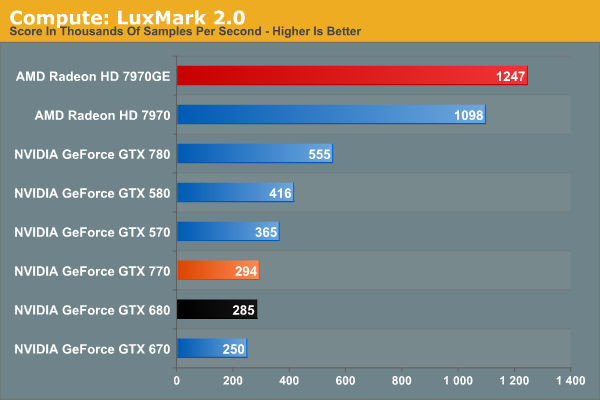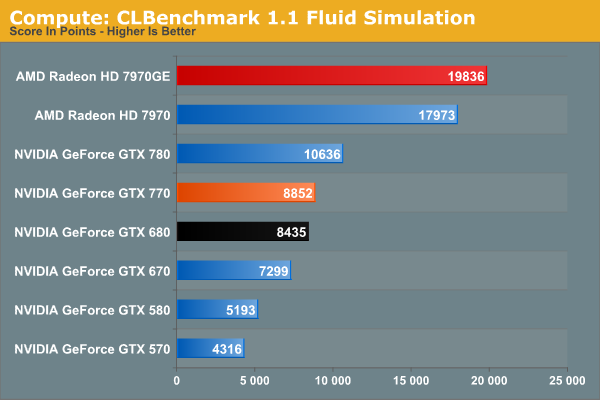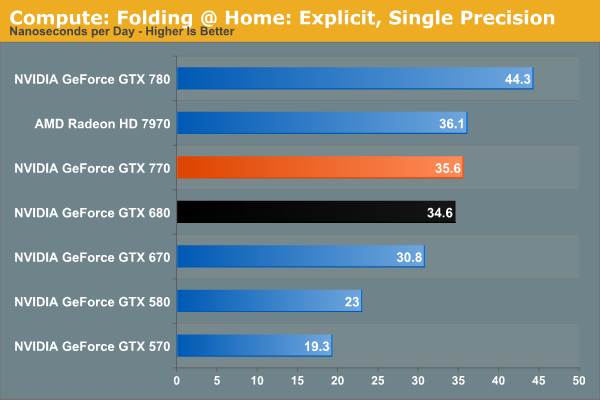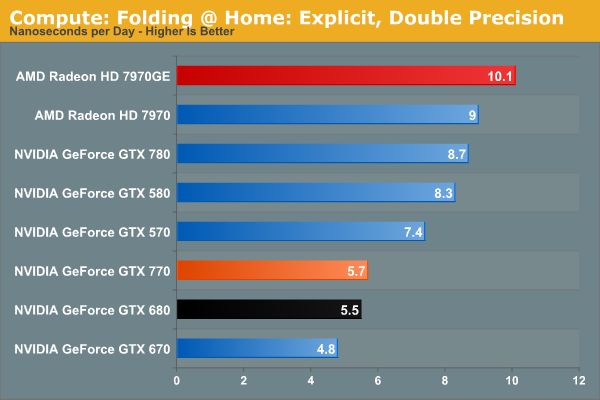NVIDIA GeForce GTX 770 Review: The $400 Fight
by Ryan Smith on May 30, 2013 9:00 AM ESTCompute
Jumping into compute, we aren’t expecting too much here. Outside of DirectCompute GK104 is generally a poor compute GPU, and other than the clockspeed boost GTX 770 doesn’t have much going for it.
As always we'll start with our DirectCompute game example, Civilization V, which uses DirectCompute to decompress textures on the fly. Civ V includes a sub-benchmark that exclusively tests the speed of their texture decompression algorithm by repeatedly decompressing the textures required for one of the game’s leader scenes. While DirectCompute is used in many games, this is one of the only games with a benchmark that can isolate the use of DirectCompute and its resulting performance.

Civilization V at least shows that NVIDIA’s DirectCompute performance is up to snuff in this case. Though as is the case with GTX 780, we’re reaching the limits of what this benchmark can do, due to just how fast modern cards have become.
Our next benchmark is LuxMark2.0, the official benchmark of SmallLuxGPU 2.0. SmallLuxGPU is an OpenCL accelerated ray tracer that is part of the larger LuxRender suite. Ray tracing has become a stronghold for GPUs in recent years as ray tracing maps well to GPU pipelines, allowing artists to render scenes much more quickly than with CPUs alone.

Moving on to a more general compute task, we get a reminder of how poor GK104 is here. GTX 770 can beat the slower GK104 products, and that’s it. Even GTX 570 is faster, never mind the massive lead that 7970GE holds.
Our 3rd benchmark set comes from CLBenchmark 1.1. CLBenchmark contains a number of subtests; we’re focusing on the most practical of them, the computer vision test and the fluid simulation test. The former being a useful proxy for computer imaging tasks where systems are required to parse images and identify features (e.g. humans), while fluid simulations are common in professional graphics work and games alike.


CLBenchmark paints GTX 770 in a better light than LuxMark, but not by a great deal. The gains over the GTX 680 are miniscule since these benchmarks aren’t memory bandwidth limited, and the gap between it and the 7970GE is nothing short of enormous.
Moving on, our 4th compute benchmark is FAHBench, the official Folding @ Home benchmark. Folding @ Home is the popular Stanford-backed research and distributed computing initiative that has work distributed to millions of volunteer computers over the internet, each of which is responsible for a tiny slice of a protein folding simulation. FAHBench can test both single precision and double precision floating point performance, with single precision being the most useful metric for most consumer cards due to their low double precision performance. Each precision has two modes, explicit and implicit, the difference being whether water atoms are included in the simulation, which adds quite a bit of work and overhead. This is another OpenCL test, as Folding @ Home has moved exclusively to OpenCL this year with FAHCore 17.


Recent core improvements in Folding @ Home continue to pay off for NVIDIA. In single precision the GTX 770 is just fast enough to hang with the 7970 vanilla, though the 7970GE is still over 10% faster. Double precision on the other hand is entirely in AMD’s favor thanks to GK104’s very poor FP64 performance.
Wrapping things up, our final compute benchmark is an in-house project developed by our very own Dr. Ian Cutress. SystemCompute is our first C++ AMP benchmark, utilizing Microsoft’s simple C++ extensions to allow the easy use of GPU computing in C++ programs. SystemCompute in turn is a collection of benchmarks for several different fundamental compute algorithms, as described in this previous article, with the final score represented in points. DirectCompute is the compute backend for C++ AMP on Windows, so this forms our other DirectCompute test.

Unlike our other compute benchmarks, System Compute is at least a little bit memory bandwidth sensitive, so GTX 770 pulls ahead of GTX 680 by 11%. Otherwise like every other compute benchmark, AMD’s cards fare far better here.










117 Comments
View All Comments
raghu78 - Thursday, May 30, 2013 - link
what most of reviews. across a wide range of games and you will see these two cards are tied.http://www.hardwarecanucks.com/forum/hardware-canu...
http://www.computerbase.de/artikel/grafikkarten/20...
http://www.pcgameshardware.de/Geforce-GTX-770-Graf...
http://www.hardware.fr/articles/896-22/recapitulat...
bitstorm - Thursday, May 30, 2013 - link
It seems to match up with other reviews I have seen. Maybe you are looking at ones that are not using the reference card? The non-reference reviews show it doing a bit better.Still even with the better results of the non reference cards it is a bit disappointing of a release from Nvidia IMO. While it is good that it will likely cause AMD to drop the price of the 7970 GE but it won't set a fire under AMD to make an impressive jump on their next lineup refresh.
Brainling - Thursday, May 30, 2013 - link
And if you look at any AMD review, you'll see fanbois jumping out of the wood work to accuse Anand and crew of being Nvidia homers. You can't win for losing I guess.kallogan - Thursday, May 30, 2013 - link
barely beats 680 at higher power consumption. Turbo boost is useless. Useless gpu. Next.gobaers - Thursday, May 30, 2013 - link
There are no bad products, only bad prices. If you want to think of this as a 680 with a price cut and modest bump, where is the harm in that?EJS1980 - Thursday, May 30, 2013 - link
Exactly!B3an - Thursday, May 30, 2013 - link
I'd glad you mentioned the 2GB VRAM issue Ryan. Because it WILL be a problem soon.In the comments for 780 review i was saying that even 3GB VRAM will probably not be enough for the next 18 months - 2 years, atleast for people who game at 2560x1600 and higher (maybe even 1080p with enough AA). As usual many short-sighted idiots didn't agree, when it should be amazingly obvious theres going to be a big VRAM usage jump when these new consoles arrive and their games start getting ported to PC. They will easily be going over 2GB.
I definitely wouldn't buy the 770 with 2GB. It's not enough and i've had problems with high-end cards running out of VRAM in the past when the 360/PS3 launched. It will happen again with 2GB cards. And it's really not a nice experience when it happens (single digit FPS) and totally unacceptable for hardware this expensive.
TheinsanegamerN - Monday, July 29, 2013 - link
people have been saying that for a long time. i heard the same thing when i bought my 550 ti's. and, 2 years later....only battlefield 3 pushed ppast the 1 GB frame buffer at 1080p, and that was on unplayable setting (everything maxed out). now, if I lower the settings to maintain at least 30fps, no problems. 700 MB usage max. mabye 750 on a huge map. now, at 1440p, i can see this being a problem for 2 gb, but i think 3gb will be just fine for a long time.just4U - Thursday, May 30, 2013 - link
I don't quite understand why Nvidia's partners wouldn't go with the reference design of the 770. I've been keenly interested in those nice high quality coolers and hoping they'd make their way into the $400 parts. It's a great selling point (I think) and disappointing to know that they won't be using them.chizow - Thursday, May 30, 2013 - link
I agree, it feels like false advertising or bait and switch given GPU Boost 2.0 relies greatly on operating temps and throttling once you hit 80C.Seems a bit irresponsible for Nvidia to send out cards like this and for reviewers to subsequently review and publish the results.